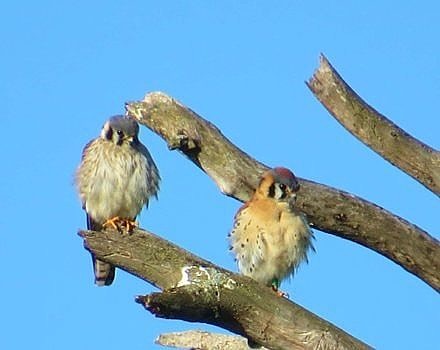Monitoring Kestrels in the Monadnock Region
Earlier this year, the Harris Center launched a new conservation research project focused on the American Kestrel, a tiny and colorful falcon of open grasslands. While some Kestrels have been observed in the Monadnock Region, little is known about our local population of this declining species.
Kestrels typically rely on abandoned woodpecker cavities — and, increasingly, manmade nest boxes — for raising their young. Recently, the Harris Center joined the ranks of the many conservation groups across North America that provide Kestrel nest boxes in appropriate grassland habitat.
Signs of Success in Hancock
This spring and summer, Harris Center Naturalist Emeritus Meade Cadot and others have been closely watching two such nest boxes in adjacent fields in Hancock. These boxes were installed by the Harris Center’s own Eric Masterson several years ago, and near as we can tell, there’s a Kestrel pair nesting in each field! One bird, a male, is even sporting a band from a research project in New Jersey, where he was banded this spring, likely on his northbound journey back to New Hampshire. In mid-July, three fledglings — one male and two females — were spotted at one of the nest sites.
A pair of American Kestrels perches near their nest site in Hancock, NH. Note the green band on the male's leg (right) — a sign that it's run into biologists before! (photo © Meade Cadot)

A Kestrel nest box on a pole in the middle of a Hancock field. (photo © Phil Brown)

Next Steps
In the fall, Harris Center staff and volunteers plan to install several more nest boxes throughout the Monadnock Region, guided by a habitat model created by an Antioch University New England graduate student Will Stollsteimer for this project. By the spring of 2023, returning Kestrels should find an abundance of suitable nesting options in our area!
How You Can Help
If you are or know a landowner with a large field who might consider hosting a Kestrel box, please let us know by emailing the Harris Center’s Bird Conservation Director, Phil Brown.


